A Practical Guide to Choosing the Right High-Visibility Gear It’s dangerous and, to be honest, confusing to walk onto a busy site without the right bright gear. It’s like wearing camouflage in a snowstorm. Whether you’re wiring streetlights or guiding trucks, this brief post will outline the basics of selecting high-visibility workwear that keeps you safe and visible.
Why Being Seen Is More Important Than You Think
Do you know that moment when headlights flash across a dark road? That neon flash could save your life. High-visibility clothing helps drivers and coworkers see you right away, which reduces the risk of accidents. And yes, it’s about following the rules for safety, but it’s really about getting home safe.
Color and Difference: Not Just Bright, But Also Right
What is the difference between neon yellow, blaze orange, and lime green? Fluorescent yellow-green stands out the most against city backgrounds during the day. At night, reflective strips turn on, sending vehicle lights back to the driver’s eyes. A bold base color and sufficient retroreflective tape are essential for working in low-light conditions.
Fit and Function: Not Everyone Fits Here
Jackets that are too loose may blow up in the wind, and vests that are too tight may pinch after hours of bending over. A good fit keeps panels flat and lets you see reflective surfaces. If you sweat a lot during long shifts in the heat, look for cuffs that can be adjusted, drop-tail hems, and zippers that allow air to circulate.
Rain or shine, material matters.
Waterproof shells keep you from getting soaked on rainy jobs, but they don’t let air flow through, so you’ll steam up inside. That’s when mesh-backed liners and fabrics that wick away moisture really shine. Choose insulated layers that allow tape to breathe for colder climates.
Extra things like pockets and hoodies
When you need to take a quick picture of a wiring diagram, a hidden chest pocket for your phone can be a big help. Hoods that tuck under collars keep rain off your face and let you see. Don’t ignore the little things; they add up to create comfort that helps you accomplish more.
Your Safety Net: Regulatory Standards
You may have seen labels with numbers like ANSI/ISEA 107 or EN ISO 20471. Those codes tell you the minimum strip width, color intensity, and design layouts. Verify that your gear is certified. It’s not legalese; it’s proof that you’re meeting industry standards for safety.
Combining and Matching Layers
You can’t depend on just one jacket in the winter or summer. Put together your base layers with reflective piping, your mid-layers with contrast panels, and your outer shells with full coverage. This way, you can handle chills, showers, or sudden changes in temperature without losing that neon edge.
Tips for keeping it bright
Cut, fade, and dirt all make it harder to see. Follow the washing instructions on the labels, avoid harsh detergents, and inspect the seams for signs of wear. If the reflective strips start to peel or the fabric loses its shine, you should replace your workwear every one to two years.
Making a budget without cutting corners
Yes, you can find cheap options online, but they may not be as wide or heavy as you want them to be. Instead, opt for mid-range items from well-established brands. Keep an eye on costs over time: the upfront cost is worthwhile because it will result in fewer replacements and less downtime due to injuries.
Personal Touch: The Moment That Surprised Me
On a foggy morning, I almost walked behind a truck that was going in reverse. My bright green vest and the driver’s quick flash of brake lights saved me. I’ll never again underestimate the importance of having the right gear after that scare. It’s not just about following the rules; it’s about feeling safe.
You can always pick the right high-visibility item if you pay attention to fit, fabric, certification, and smart layering. It’s not just about wearing bright clothes; it’s one of the best things you can do to stay safe.

